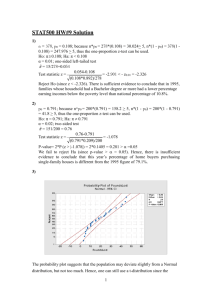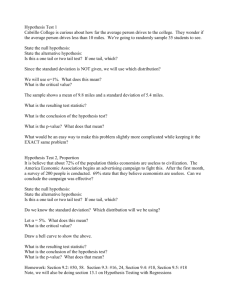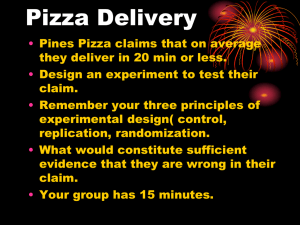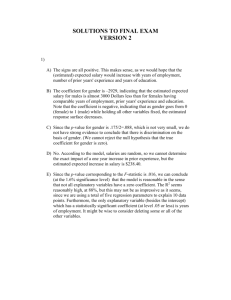Unit-18-Single-Sample-Testing-of
advertisement
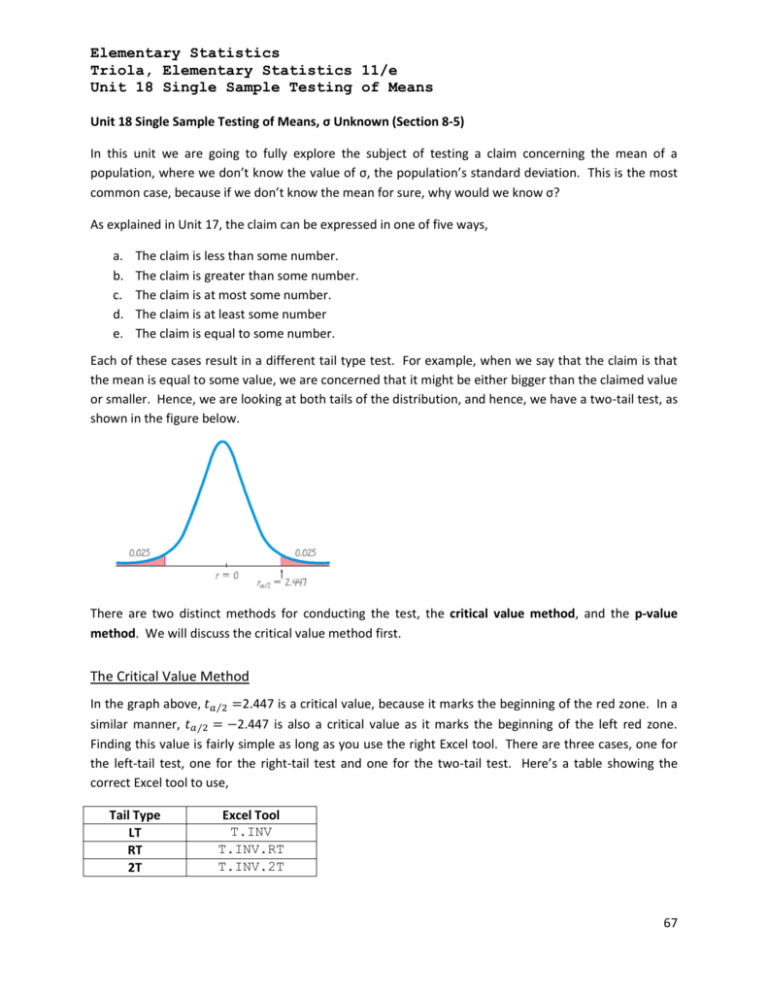
Elementary Statistics Triola, Elementary Statistics 11/e Unit 18 Single Sample Testing of Means Unit 18 Single Sample Testing of Means, σ Unknown (Section 8-5) In this unit we are going to fully explore the subject of testing a claim concerning the mean of a population, where we don’t know the value of σ, the population’s standard deviation. This is the most common case, because if we don’t know the mean for sure, why would we know σ? As explained in Unit 17, the claim can be expressed in one of five ways, a. b. c. d. e. The claim is less than some number. The claim is greater than some number. The claim is at most some number. The claim is at least some number The claim is equal to some number. Each of these cases result in a different tail type test. For example, when we say that the claim is that the mean is equal to some value, we are concerned that it might be either bigger than the claimed value or smaller. Hence, we are looking at both tails of the distribution, and hence, we have a two-tail test, as shown in the figure below. There are two distinct methods for conducting the test, the critical value method, and the p-value method. We will discuss the critical value method first. The Critical Value Method In the graph above, 𝑡𝑎⁄2 =2.447 is a critical value, because it marks the beginning of the red zone. In a similar manner, 𝑡𝑎⁄2 = −2.447 is also a critical value as it marks the beginning of the left red zone. Finding this value is fairly simple as long as you use the right Excel tool. There are three cases, one for the left-tail test, one for the right-tail test and one for the two-tail test. Here’s a table showing the correct Excel tool to use, Tail Type LT RT 2T Excel Tool T.INV T.INV.RT T.INV.2T 67 Elementary Statistics Triola, Elementary Statistics 11/e Unit 18 Single Sample Testing of Means Here are three examples showing how each tool is used. Case 1 LT Test 𝐻0 : 𝜇 = 𝑠𝑜𝑚𝑒 𝑐𝑙𝑎𝑖𝑚 𝐻1 : 𝜇 < 𝑠𝑜𝑚𝑒 𝑐𝑙𝑎𝑖𝑚 𝑥̅ = 25.08 𝑠 = .875 𝑛 = 30 𝐶. 𝐿. = 95% (𝛼 = 0.05) 𝑡𝑎⁄2 = T. INV(α, df) = T. INV(0.05, 29) = −1.6991 Notice that the critical value is negative, which makes perfectly good sense since we’re concerned about ending up in the left red zone. Now, let’s take a look at a right tail test. Case 2 RT Test 𝐻0 : 𝜇 = 𝑠𝑜𝑚𝑒 𝑐𝑙𝑎𝑖𝑚 𝐻1 : 𝜇 > 𝑠𝑜𝑚𝑒 𝑐𝑙𝑎𝑖𝑚 𝑥̅ = 25.08 𝑠 = .875 𝑛 = 30 𝐶. 𝐿. = 95% (𝛼 = 0.05) There’s one huge wrinkle and it’s because Microsoft is a crap company. There is no T.INV.RT! What to do? Well, we can use T.INV, but instead of using 𝛼 for the probability, we use 1 − 𝛼. Hence, 𝑡𝑎⁄2 = T. INV. RT(1 − α, df) = T. INV. RT(0.95, 29) = 1.6991 Note that the critical value is the same number as for Case 1, but now it’s positive. Since the Student-t distribution is symmetrical this should come as no big surprise. Finally, we deal with the two-tail case. Case 1 2T Test 𝐻0 : 𝜇 = 𝑠𝑜𝑚𝑒 𝑐𝑙𝑎𝑖𝑚 𝐻1 : 𝜇 ≠ 𝑠𝑜𝑚𝑒 𝑐𝑙𝑎𝑖𝑚 𝑥̅ = 25.08 𝑠 = .875 𝑛 = 30 𝐶. 𝐿. = 95% (𝛼 = 0.05) 𝑡𝑎⁄2 = T. INV. 2T(α, df) = T. INV. 2T(0.05, 29) = 2.0452 Ok, now that we’ve got the critical values, what do we do with them? Well, we want to know if our calculated t-score (see the previous unit) lies in the red zone, and we do that by comparing our t-score to the critical value. Again, we have to consider the tail type test we’re doing. First, we calculate our tscore, 𝑡= 𝑥̅ − 𝜇 √𝑛 𝑠 where the value of 𝜇 is the claim 68 Elementary Statistics Triola, Elementary Statistics 11/e Unit 18 Single Sample Testing of Means Then we do the following comparisons, Left Tail If the t-score < critical value (they both would be negative numbers) then the t-score is going to be in the left red zone and we would reject the null hypothesis. Otherwise, we fail to reject the null hypothesis. Right Tail If the t-score > critical value then the t-score is in the right red zone and we would reject the null hypothesis. Otherwise, we fail to reject the null hypothesis. Two Tail If the absolute value of the t-score < critical value, we reject the null hypothesis. Remember to first take the absolute value of the t-score before comparing it to the two-tail critical value. You do this just for the two-tail test. Otherwise, we fail to reject the null hypothesis. The p-Value Method The p-Value Method works by comparing areas under the curve. In a single tail test and given that the confidence level is 95%, the area under the tail is 0.05, which is the value of 𝛼, the significance. If we found the area to the right (RT test) or left (LT test) of our calculated t score, and that area was less than 𝛼, then the t-score would have to be in the red zone. Look at the graph at the top and think about it. This area that is to the right or left of our t is called the p-Value. The rule for rejecting the null hypothesis is very simple, because there is only one rule, regardless of the type of tail test. If p-Value < 𝛼, then reject the null hypothesis, otherwise, fail to reject it. We find the p-Value with Excel. t is the calculated t score and df are the degrees of freedom: Left Tail Test p-Value = T.DIST(t, df) Right Tail Test p-Value = T.DIST.RT(t, df) Two Tail Test p-Vale = T.DIST.2T(|𝑡|, df) Notice the absolute value brackets around t. That’s because T.DIST.2T only works with positive values, even though a negative t would be a valid value; another ‘gift’ from Microsoft. 69 Elementary Statistics Triola, Elementary Statistics 11/e Unit 18 Single Sample Testing of Means Worked Example Let’s say that we work for the4 Coca-Cola Company, and it’s our job to verify that, on average, the cans of coke going out the door contain 12 oz. This is a two-tail test because, on one hand we don’t want the cans to contain less than 12 oz because then we can be accused of false labeling. On the other hand, we don’t want them to contain more than 12 oz, because, while nobody is likely to complain, we would be giving product away for nothing. We collect a simple random sample of 20 cans and calculate the following statistics, 𝑥̅ = 11.98 𝑠 = .76 𝑛 = 20 We’ll use a 95% confidence level for our test. Hypotheses Statement 𝐻0 : 𝜇 = 12.00 𝐻1 : 𝜇 ≠ 12.00 Calculated t score 𝑡= 𝑥̅ − 𝜇 11.96 − 12.00 √20 = 0.1177 √𝑛 = 𝑠 0.76 Critical Value and p-Value Here’s a spreadsheet for calculating both the critical value and the p-Value. Click on the values for t, t critical value and pValue to see how these were calculated. Note that we are using the absolute value when calculating the t score because this is a two-tail test. x 11.98 s n 0.76 20 claim t 12 0.117688 CL t crit val p-Value 0.95 2.093024 0.90755 Here’s a subtle point concerning the p-Value of a two tail test. The p-Value is the sum of the areas under both tails. This is the value we compare to 𝛼 which is also the sum of the two red zones. Result Critical Value Method 𝑡 < 𝑡𝑎⁄2 (the critical value), therefore fail to reject the Null Hypothesis. p-Value Method p-Value < 𝛼, therefore fail to reject the Null Hypothesis Conclusion On the basis of our evidence, we cannot reject the claim that the cans of Coke contain, on average, 12 oz of Coca-Cola. If you look under Miscellaneous on the website, Hypotheses Testing Chart SSM is a wonderful summary of this Unit. This is the end of Unit 18. In class, you will get more practice with these concepts by working exercises in MyMathLab. 70




